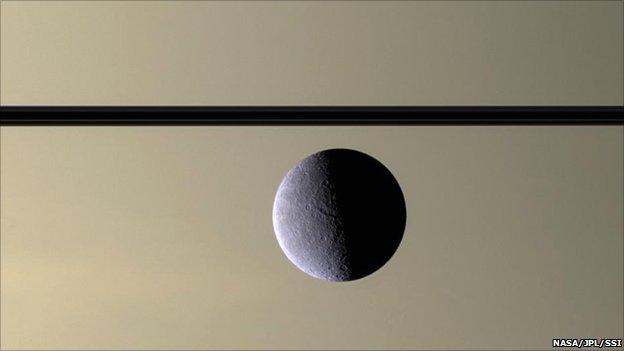Saturn's moon Rhea has thin atmosphere
- Published

Rhea is pictured against Saturn's atmosphere and its edge-on rings
Rhea, the second biggest moon of Saturn, has an atmosphere of oxygen and carbon dioxide, scientists say.
It is incredibly thin, however. The density of O2, for example, is probably about five trillion times less dense than the oxygen that blankets Earth.
The presence of an exosphere, as it is more properly called, was confirmed by instruments on the Cassini probe which orbits the ringed planet and its moons.
The discovery is reported in the online version of Science magazine.
Oxygen exospheres have been seen at Jupiter's moons Europa and Ganymede, but this is the first time such a detection has been made in the Saturnian system.
Ben Teolis and colleagues say the tenuous envelope around Rhea is maintained by high-energy particles that constantly bombard the moon's icy surface.
"As the magnetic field rotates around Saturn, particles carried in the field slam into the hemisphere of Rhea that's facing their flow," Dr Teolis from the Southwest Research Institute in San Antonio, US, told BBC News.
"They hit that hemisphere and break water molecules on the surface. The atoms are then rearranging themselves to make O2 molecules, which are sputtered from the surface by additional impacting particles."
It is an ongoing process. As fast as the oxygen is created, energetic processes around Rhea are whipping the O2 molecules out into space.
The mechanism driving the production of carbon dioxide is less obvious, say the researchers.
Some of it, like the O2, could be being produced as a result of high-energy particle impacts. Such CO2 could certainly result if organic compounds are present in the surface ice.
It is possible also that the carbon dioxide was made in deep sub-surface processes and the CO2 is slowly escaping the moon's body.
Previous efforts to try to identify an exosphere at Rhea using Earth telescopes and even the remote-sensing instruments on Cassini had failed.
Only by getting up close to Rhea could Cassini make a positive detection.
"What we've been able to do now with Cassini is actually fly through this atmosphere and measure it in situ - to 'sniff' and 'taste' it, and find out what it's made of," said co-author Professor Andrew Coates from the Mullard Space Science Laboratory, University College London, UK.
The probe's ion and neutral mass spectrometer (INMS) measured peak densities of oxygen of about 50 billion molecules per cubic metre . It detected peak densities of carbon dioxide of about 20 billion molecules per cubic metre (about 600 million molecules per cubic foot).
"All this suggests these kinds of exospheres may be very common," said Dr Teolis. "There are different moons at Saturn and at Uranus, for example, which should be massive enough to hold an atmosphere. And, presumably, this kind of thing is duplicated billions of times throughout the galaxy. This could be something happening all over the place."
Other good candidates at Saturn might include the moons Dione and Tethys. No close flybys of Tethys are planned in the remaining years of the Cassini mission, but the probe will get near enough to Dione in December 2011 to try to make a direct detection of an exosphere.
Cassini is a joint venture between the US space agency (Nasa), the European Space Agency (Esa) and the Italian Space Agency (ASI).
Its mission has been extended up until 2017 when it will be commanded to destroy itself by plunging into Saturn's atmosphere.
- Published6 October 2010